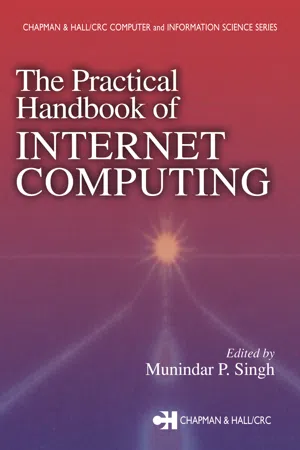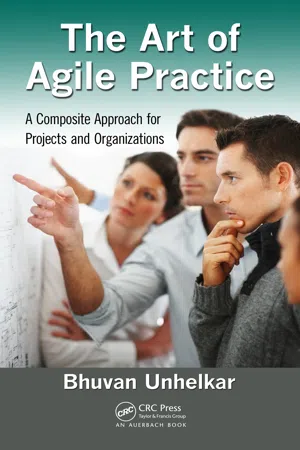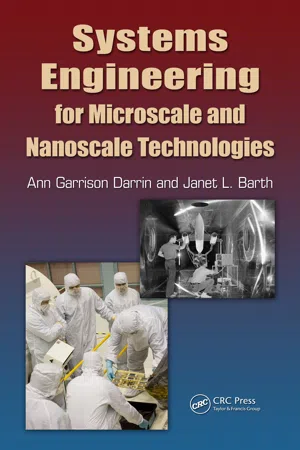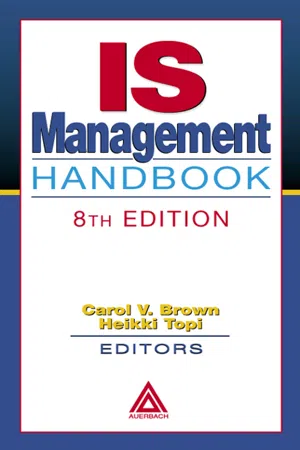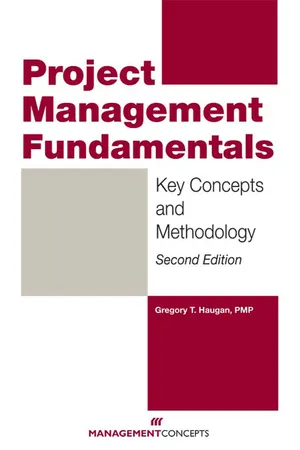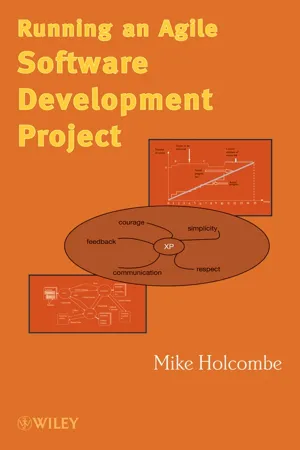Computer Science
Agile Methodology
Agile methodology is a software development approach that emphasizes flexibility, collaboration, and iterative development. It prioritizes customer feedback and adapts to changing requirements throughout the development process. Agile methodologies, such as Scrum and Kanban, promote continuous improvement and aim to deliver high-quality software in a more efficient and responsive manner.
Written by Perlego with AI-assistance
Related key terms
1 of 5
11 Key excerpts on "Agile Methodology"
- eBook - PDF
- Munindar P. Singh(Author)
- 2004(Publication Date)
- Chapman and Hall/CRC(Publisher)
The agile methodologies welcome changing requirements, even late in the development cycle. A minimal timebox is dedicated toward collecting an initial set of require-ments. A specified, agreed-upon subset of these requirements is completed in each short iteration. The 43 -6 The Practical Handbook of Internet Computing focus is on producing working software, rather than documents. At the end of each iteration, the customer is shown the product and asked, “How do you like that? Now that you see what we’ve done, what would you like us to do for the next iteration?” In this manner, the requirements emerge, leading toward the delivery of what the customer really wants and providing them with the best competitive advantage possible in the face of constant change and turbulence. 43.3.3 Self-Organization Agile methodologies give the entire development team the autonomy to self-organize themselves to determine the best way to get the job done. Team members are not constrained by predetermined roles or required to execute obsolete task plans. Managers of agile teams place a great deal of trust and confidence in the entire team. In the self-organization, the emphasis is on face-to-face conversations rather than on communicating through formal (or informal) documents. Software developers talk with software developers, business people talk with software developers, customers talk directly with either business people or software developers. Agile methodologies also advocate the use of retrospective meetings in which team members reflect on how to become more effective. The team then tunes and adjusts its behavior accordingly. Through these values and philosophies, agile methodologists contend that they are better able to respond to volatile demands, such as are found in Internet applications. Because change is allowed, some rework is inevitable. The goal is to increase the possibility of delivering what the customer really wants, rather than their initial view of their desires. - eBook - PDF
The Art of Agile Practice
A Composite Approach for Projects and Organizations
- Bhuvan Unhelkar(Author)
- 2016(Publication Date)
- Auerbach Publications(Publisher)
The art of Agile in practice explores and capitalizes on the possibilities offered by information manage-ment, mobile technologies, business intelligence, knowledge management, and service orientation to create an Agile ecosystem in and around the business. The ensuing balance between the core and noncore business processes renders the entire organization collaborative, Lean, and Agile. Despite these virtues of agility in business, whenever a discussion on Agile methods is broached, attention usually is directed toward Agile software development methods such as Scrum, XP, test-driven development (TDD), and Crystal—to name but a few. The popularity of Agile methods in software development can be attributed to their promise to accommodate change and deliver rapidly to the expectations of business references (Unhelkar, 2010). Alan Radding, back in 2002, described “these new programming methodologies” as “ adaptive —because they react to changing user input, Agile —for their frequent iterations and continual testing, and lightweight —because Enterprise Agility (Lean, Agile, Cloud, Process) En Enterprise Agility nte ility (Lean, A ile, Cloud, Process) Ag ile, Cloud, Proce A ile, Clo oud, Pr ocess) an, A Enterprise Agility (Lean, Agile, Cloud, Process) External environment Internal response Time Figure 1.1 Agility reflects an organization’s ability to respond to both external and internal changes. Introducing Agile in Practice ◾ 5 they emphasize small teams and downplay documentation.” Such characteristics of a software development team, in fact, any team, are viewed as beneficial because of the promise of adding immediate value to business by enabling and accommodating change. In the context of software development, Agile is viewed as a method (methodology) within the solution space. Prior to the advent of the Agile method(s), software development was characterized by planned methods. - eBook - ePub
Going Beyond the Waterfall
Managing Scope Effectively Across the Project Life Cycle
- Barbara Davis, Darren Radford(Authors)
- 2014(Publication Date)
- J. Ross Publishing(Publisher)
SECTION 3: APPLYING PROJECT AND ARCHITECTURE METHODOLOGIESPassage contains an image IMPLICATIONS OF AGILE ON SCOPE
There is increasing pressure on organizations to deliver working solutions to business in ever-shorter timescales without compromising quality. The processes by which solutions are developed must be agile and deliver what the business needs, when it needs it.WHAT IS AGILE?In this context, Agile development is a group of methods that provides a flexible yet controlled process that can be used to deliver solutions. Historically, the development methods have been applied to software development, but agile methods can be used for initiatives that have no technology element at all.In the project context, Agile is a delivery method based on iterative, incremental, and evolutionary development and delivery principles, as originally defined by Watts Humphries (IBM) and Hadar Ziv (University of California). It was designed as a means to deliver blocks of usable functionality in increments through short development and delivery cycles, typically called “sprints.” This “speed of delivery” represents one key differentiator between the traditional, sequential methodology known as “Waterfall.” Agile principles consider requirements as uncertain and even indefinable until the end user has had the chance to work with the solution, with both requirements and the solution evolving through collaboration as the project progresses. “Uncertainty is inherent and inevitable in software development processes and products.”1 By delivering blocks of functionality in each sprint, the end users then have the opportunity to work with and comment on the product as it is being developed and refined.Each sprint is directed by a person called a “scrum master,” and can be anywhere from two to four weeks in duration. Figure 7.1 - eBook - ePub
Hands-On Software Engineering with Python
Move beyond basic programming and construct reliable and efficient software with complex code
- Brian Allbee(Author)
- 2018(Publication Date)
- Packt Publishing(Publisher)
- Build projects around motivated individuals. Give them the environment and support they need, and trust them to get the job done.
- The most efficient and effective method of conveying information to and within a development team is face-to-face conversation.
- Working software is the primary measure of progress.
- Agile processes promote sustainable development. Sponsors, developers, and users should be able to maintain a constant pace indefinitely.
- Continuous attention to technical excellence and good design enhances agility.
- Simplicity—the art of maximizing the amount of work not done—is essential.
- The best architectures, requirements, and designs emerge from self-organizing teams.
- At regular intervals, the team reflects on how to become more effective, then tunes and adjusts its behavior accordingly.
You may refer to The Agile Manifesto at http://Agilemanifesto.org/ for more details.In an application, these principles lead to a few common characteristics across different methodologies. There may be exceptions in other methodologies that are still considered Agile, but for our purposes, and with respect to the specific methodologies discussed here, those common traits are as follows:- Development happens in a sequence of iterations, each of which has one to many goals
- Each goal is a subset of the final system
- At the conclusion of each iteration, the system is deployable and operational (perhaps only for a given value of operational)
- Requirements are defined in detail in small chunks, and may not be defined at all until just before the iteration that they're going to be worked on
Scrum is claimed to be the most popular, or at least most widely used, Agile development methodology (the12th Annual Stateof Agile Report - M. Ann Garrison Darrin, Janet L. Barth(Authors)
- 2016(Publication Date)
- CRC Press(Publisher)
9 Many of these meth-ods began in the field of software development, but in recent years, a variety of industries including pharmaceuticals, software, automobiles, and integrated circuits have begun to explore agile product development. 10 A comprehensive sur-vey of the many agile methodologies is beyond the scope of this chapter, although summaries of three popular methods: Scrum, 11–15 Extreme Programming, 16–18 and Kanban, 19–23 will provide a good picture of how the principles of agile product development can be implemented in practice. Scrum The term scrum was initially applied to product development in an article by Hirotaka Takeuchi and Ikujiro Nonaka in the Harvard Business Review in 1986. 12 The concept of Scrum evolved from the original idea of relating product development to the game of rugby where a self-organizing team moves col-lectively down the field toward a goal. These initial ideas were further developed and formalized in the mid-1990s by Ken Schwaber and Jeff Sutherland. 13 The resulting project man-agement approach known as Scrum is a framework of meth-ods used to obtain incremental functional products from small self-organizing teams on a cyclical, iterative basis. Figure 4.4 illustrates the Scrum development methodology. A Scrum team consists of a product owner, a Scrum master, and the team members. The product owner is responsible for determining the most desirable product features while mini-mizing the cost-to-benefit ratio, which can be literally applied 80 Systems Engineering for Microscale and Nanoscale Technologies to commercial products or more abstractly applied to balanc-ing different demands within research environments. The product owner will frequently interact with the Scrum mas-ter and the Scrum team to help prioritize features as scope or demands change.- eBook - ePub
Mastering Software Project Requirements
A Framework for Successful Planning, Development & Alignment
- Barbara Davis(Author)
- 2013(Publication Date)
- J. Ross Publishing(Publisher)
SECTION IV APPLYING PROJECT AND ARCHITECTURE METHODOLOGIESPassage contains an image Implications of Agile on Requirements
Agile is an iterative process for the software development life cycle. It was intended to deliver functionality in small increments within shorter time frames than more traditional life cycles. It is based upon the principles put forward by Watts Humphries of IBM and Hadar Ziv of the University of California that requirements are uncertain until people have had the chance to work and play with the solution.“Uncertainty is inherent and inevitable in software development processes and products.”1The Agile process runs in short iterations, called “sprints,” and each sprint is guided by a person in the role of a “scrum master.” These sprints can be anywhere from two to four weeks. Figure 10.1 illustrates the agile process.The Agile process begins with the road map to value. This road map provides a high-level view of the overall project and identifies several stages that will enable the project to progress from concept to product in a clearly defined manner. These stages are product vision, product road map, release plan, sprint planning, sprint review, and the sprint retrospective. Figure 10.2 illustrates the agile road map to value.In the first stage (also known as initial planning), the product vision is defined in collaboration with the product owner. This vision clearly defines the product, how it will support the business and its strategy, as well as who will use the product, and how this product will be used.In the second stage (also known as planning), the product road map is defined in collaboration with the scrum master and the product owner. This road map provides a high-level view of the requirements, with a rough time frame for developing and delivering those requirements. The road map is only effective when it contains details about the product and the effort required to develop and implement this product. In this case, these details include requirements, prioritization of those requirements, and an estimation of the effort to develop and implement those specific requirements. - eBook - ePub
- Bhuvan Unhelkar(Author)
- 2017(Publication Date)
- Auerbach Publications(Publisher)
This manifesto characterizes Agile as “a value statement not a concrete plan or process” 13 — thereby laying the foundation for extensive collaboration and iterations through the Agile values, priorities, and principles. Agile can also imply intense focus on delivery (DevOps, 2015), 14 closely accompanied by continuous testing and integration (Mistry, 2015). 15 Scrum — An Agile Approach Highly popular in the Agile space, Scrum is a lightweight process that employs iterative and incremental practices 16 (Scrum is a game mechanic derived from the sport of Rugby 17). Scrum aims to get the entire project team together to set a shared and achievable goal. The team sprints toward this common goal. Collaborations and iterations ensure that the product is developed incrementally. Scrum projects are characterized by trust, simplicity, and courage—implemented through visual charting, daily standup meetings, and close collaboration. Roles, Ceremonies, and Artifacts An Agile method (typically Scrum) has the following elements: roles, ceremonies, and artifacts (shown in Figure 4.6). These Agile elements are put together dynamically in software development projects. However, these Agile elements can also be used in other nonsoftware initiatives in the organization. For example, business decision-making benefits by the application of Agile elements. A brief description of these three categories of Agile elements (roles, ceremonies, and artifacts) and the way they are used in software projects follows. Figure 4.6 Three categories of Agile elements. Roles Agile methods have limited project roles (Figure 4.6). This is because Agile is results-oriented. Large numbers of roles with elaborate descriptions are not required in Agile. Typical Agile roles (and their specific terms in Scrum) are as follows: ■ Agile coach (Scrum master)—this role is that of a facilitator who encourages the team to reach its goals. The coach also protects the team from external pressures - eBook - PDF
- Alan Dennis, Barbara Wixom, Roberta M. Roth(Authors)
- 2021(Publication Date)
- Wiley(Publisher)
13 418 Agile Development Methods In this textbook, we have focused on structured information system development methods. We have used the traditional systems development life cycle (SDLC) as the organizing framework to present a coherent overview of the phases, steps, tasks, and tools of systems development. As we saw in Chapter 2, however, the process of developing information systems has continuously evolved over time, from the earliest waterfall method through rapid application development methods to our current emphasis on development approaches with agility. Many organizations have adopted or are experimenting with Agile development approaches, and we conclude our textbook with a more comprehensive look at this important category of development approaches. OBJECTIVES • Be able to describe the Agile values and principles expressed in the Agile Manifesto • Be able to explain the benefits organizations gain by using Agile development approaches • Be able to describe the overall structure of the Scrum development approach • Be able to list and explain four key characteristics of Scrum • Be able to describe the roles of product owner, ScrumMaster, and the team in Scrum • Be able to discuss the key unique features of Scrum: sprints, user stories, acceptance criteria, story points, and team velocity • Be able to explain the sprint planning process • Be able to explain the product backlog grooming process • Be able to discuss the purpose and contribution of Scrum’s six distinctive meeting types • Be able to briefly describe other common Agile approaches • Be able to describe the factors that limit the adoption of Agile development approaches in organizations today Introduction The concept of business agility is not new. Global competitive pressures have led many organi- zations to reexamine their business operations to improve competitive responsiveness. - eBook - PDF
- Carol V. Brown, Heikki Topi(Authors)
- 2003(Publication Date)
- Auerbach Publications(Publisher)
511 0-8493-1595-6/03/$0.00+$1.50 © 2003 by CRC Press LLC Chapter 41 Extreme Programming and Agile Software Development Methodologies Lowell Lindstrom Ron Jeffries As a stakeholder of a software project, how does the following sound to you? You can have releases as often as you like. The small number of defects is unprecedented. All of the features in the system are the most valuable ones to your business. At anytime, you have access to complete, accurate information as the status of any feature and of the quality of the system as a whole. The team developing your project works in an ener-gized space with constant communication about the project. You are not dependent on any one or even two programmers for the continued success of the project. If your needs change, the development team welcomes the change of direction. As a developer of a software project, how does the following sound to you? No one estimates your tasks but you, period! You always have access to a customer to clarify details about the features you are implementing. You are free (and required) to clean up the code whenever necessary. You complete a project every two weeks. You can work in any part of the sys-tem that you wish. You can pick who will help you on any given task. You are not required to constantly work long hours. Does this sound too good to be true? Teams are achieving these advan-tages using a relatively new set of software methodologies. Collectively, 512 PROVIDING APPLICATION SOLUTIONS they are referred to as Agile Software Development Methodologies. The most pervasive is Extreme Programming. This chapter introduces these exciting, popular, yet controversial new approaches to software develop-ment. BACKGROUND Trends in Software Development The last half-century has seen a dizzying progression of technical advance-ment in the areas of computer, software, and communications technology. With each advance came rapid changes in the way society works and lives. - eBook - ePub
Project Management Fundamentals
Key Concepts and Methodology
- Gregory T. Haugan PhD, PMP(Authors)
- 2010(Publication Date)
- Berrett-Koehler Publishers(Publisher)
3Many years later, in February 2001, a group of 17 software experts got together in Snowbird, Utah, to discuss the concept of “lightweight” software development methods. The programmers were interested in developing an alternative to the “heavyweight” methods—highly documented, structured approaches—programmers used at major software companies to develop large systems.The meeting in Snowbird produced what is now called the “Agile Manifesto,” presented in Figure 5.3 .4Figure 5.3. Manifesto for Agile Software DevelopmentThe Agile Methodology emphasizes “close collaboration between the programmer team and business experts; face-to-face communication (as more efficient than written documentation); frequent delivery of new deployable business value; tight, self-organizing teams; and ways to craft the code and the team such that the inevitable requirements churn is not a crisis.”5The Agile Manifesto highlighted a growing movement in the software development community. Its principles reflected changing attitudes about the practice of software engineering—new approaches had to be adaptable to rapid change while minimizing overheads. Several software development methodologies emerged to implement these agile principles.AGILE SOFTWARE DEVELOPMENT METHODOLOGIES
Presenting examples of agile software methodologies reiterates the principles of agile project management, and readers can extrapolate these principles into their own individual situations. Some agile software methodologies in use today include: - Mike Holcombe(Author)
- 2008(Publication Date)
- Wiley(Publisher)
W.S. HUMPHREYS. A Discipline for Software Engineering. Addison-Wesley, 1995. D. HUNTER. Beginning XML. Wrox Press, 2000. R.S. PRESSMAN. Software Engineering: A Practitioner’s Approach. McGraw Hill, 2000. K. SCHWABER, M. BEEDLE. Agile Software Development with SCRUM. Prentice Hall, 2002. I. SOMMERVILLE. Software Engineering, 8th ed. Addison-Wesley, 2006. J. STAPLETON. DSDM: The Dynamic Systems Development Method. Addison-Wesley, 1997. J. SUTHERLAND, A. VIKTOROV, J. BLOUNT, N. PUNTIKOV. Proc. HICSS. 2007. Web Sites http://www.Poppendieck2002.com. 18 Chapter 1 What Is an Agile Methodology? Chapter 2 Extreme Programming Outlined SUMMARY The fundamental principles and the 5 values and the 12 activities involved in extreme programming (XP) are introduced. These are reviewed and discussed in the light of some current experiences in applying XP in industry. 2.1 SOME GUIDING PRINCIPLES Before we get into the details of the main approach taken in the book, an evolution of extreme programming (XP), which incorporates many of the aspects described in the agile methods discussed in Chapter 1, we will consider some of the issues from a broader perspective. Software development is a human activity, and we must ensure that the human dimension is at the center of our thoughts when we discuss ways to make software more effectively. There is a social dimension in which groups of people (developers, customers, managers) collaborate together to achieve a common aim—the development of a soft- ware solution to a business problem. However, it is not just the achievement of this that is important. We all develop and learn as individuals and groups, and this has to be at the forefront of things as well. There are a number of social principles that apply here. No project is without its challenges, and any group of people comes with its dynamic relationships.
Index pages curate the most relevant extracts from our library of academic textbooks. They’ve been created using an in-house natural language model (NLM), each adding context and meaning to key research topics.
